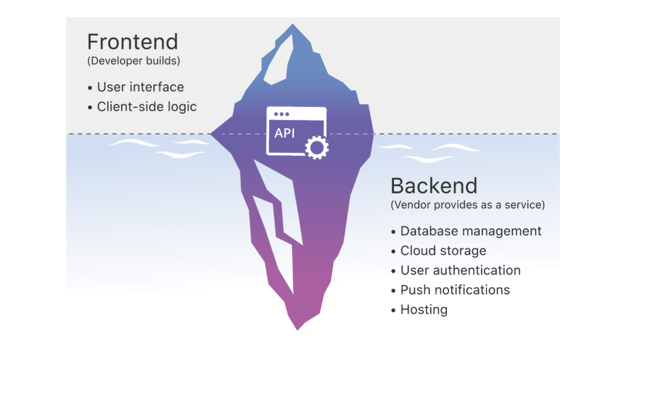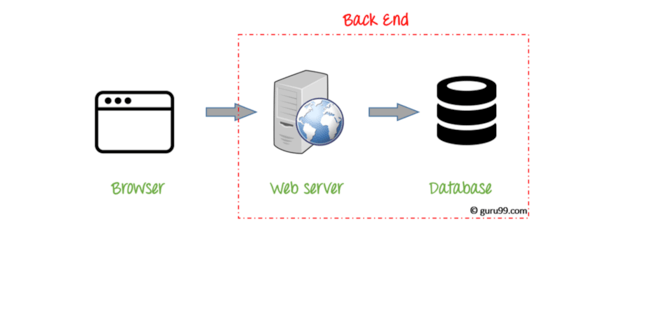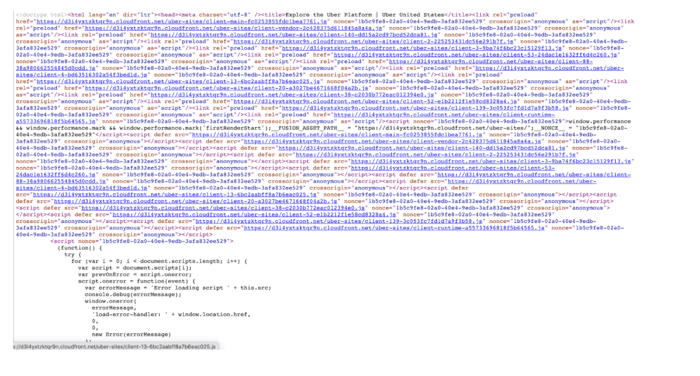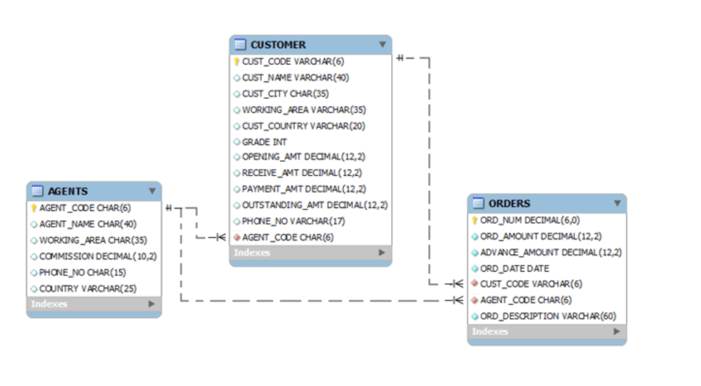
In this backend servers for mobile apps guide we will cover pretty much everything you need to know about what they are, how they work and why you need them when developing an app.
While an app idea is easy to come by, the technical decisions you need to make once ready for implementation is another story.

You have to think about what tech stack will be most efficient for your project, what OS will best serve your audience, and whether or not your app needs a backend.
Sure, building a mobile app can be an extremely profitable endeavor, but there’s much to think about and many layers of complexity involved in order to build something functional and responsive.
If tech isn’t your thing, I break down how to get the heavy-lifting done in this video.
When people think of what’s needed for an app, they often imagine the frontend – like how various design elements will look and what colors they’ll use to make it stand out.
While UX and UI certainly have its place, not everyone considers the backend of their mobile app project since it’s not quite visible to the user.
This image from Cloudflare perfectly illustrates the concept of frontend vs backend and likens it to an iceberg where the frontend is the small top part you see, while the backend is a huge portion you don’t see.

Backend Servers for Mobile Apps guide
It’s not sexy, but let’s talk about backend servers and why your mobile app project needs one.
The easiest way to explain what a backend server is by comparing it to a restaurant.
When a customer – or the user – goes to a restaurant, they only ever interact with their waiter or waitress. Think of this as the frontend of a mobile app.
Once they place their order, it’s taken to the kitchen and made. The customer, in most cases, never sees what goes on in the kitchen.
They only see their order being taken in and their order being delivered to their table.
Think of the kitchen as how a backend server would operate. It doesn’t directly interact with the user, but it’s used to process requests and deliver content.
Without the kitchen, the restaurant would fall apart. Orders wouldn’t be fulfilled and the overall customer (user) experience would be poor, to say the least.
It has its place in bringing value to the dining experience, just as a backend server brings value to the user experience.
Backend servers are most often built with PHP and Python, but plenty of other languages can also work. This is used to manage backend processes as the server communicates with the client.
As long as it serves the purpose of delivering content and responding to requests quickly and reliably, it’s doing its job.
Below you can see the various parts. A browser, a server, and a database.

A backend server is used for a variety of different applications across the internet and can deliver a wide range of content.
Every time a user accesses anything across the internet, they are delivered that content through a backend server.
HTML, CSS, JavaScript, and multiple other languages and formats are among what can be held in the backend.
If you visit Uber’s website and inspect the source code, you’ll see a page filled with HTML code pulling in CSS and Javascript.

For the most part, a webpage’s static assets would be separate from other uses of the server such as a database that holds structured and unstructured data for the user which can include media like videos, images, or documents.
Common Usage
Everything you access on the internet uses a backend server in some way to deliver content to you.
Whether it’s a webpage, a mobile app, or a streaming service—it all has a backend server running processes to ensure that content is being delivered.
When the user connects or requests anything from a webpage, the backend server sends these elements to the client/user.
In the instance of a webpage, when you initially access a website, the backend server delivers the HTML, CSS, or any JavaScript elements that create the webpage in its entirety.
This works similarly with sites that stream content on-demand. When the user requests a video, the backend server sends pieces of the video (this is why there’s buffering.
The entire video isn’t sent at once). Without a backend server, this server could not exist.
Mobile apps are pretty similar, but the assets are specific to that mobile app and whatever operating system the user is currently using.
While the static elements may be saved on the phone itself, ads, user data, and any information a service would need to send to the user are loaded from the backend server and sent to them.
Why Do I Need One for My Mobile App Project?
Without a backend server, your app won’t be able to communicate with the user.
As long as you need to send something to the user or have them send something to you, you absolutely need a backend server.
Some entrepreneurs or developers will kid themselves and try to save a buck by thinking they can exclude a backend server from their “simple” mobile app, but trust me when I say this will not serve you in the long run. Not if you want a successful mobile app.
Almost every single mobile app on the market today sends and receives something from the user.
Whether it’s user data, advertisements, or media, a backend server and processes hold and deliver these things to the user.
Since you plan on building a mobile app, the user will require some intractability from the application.
Mobile apps today all offer some sort of interactive elements since it is not just a static page that offers information to the user.
For this, you will absolutely need a backend server.
Types of Databases
As already mentioned, a database is a major component of a backend server.
Since all of the application’s data needs to be stored, building and managing a database is key in backend development.
There are plenty of different types of databases though, so choosing one that’s right for your project can be a daunting task.
We’ll explore some options here, but it’s always best to discuss this with the developers since they’re the ones working on your project.
SQL Databases
SQL is a programming language that specializes in managing data in relational databases.
These databases contain mostly structured data that can easily be added to tables that connect, thus creating a relational database.
For these databases, SQL is used to create, delete, and retrieve data, along with managing the database as a whole.
In certain uses, this type of structured querying is extremely beneficial.
If the data is easily structured into certain categories, a SQL database is what you need.
There are a few options when it comes to SQL databases which each offer their own spin on SQL and database management as a whole.
Services like Microsoft’s SQL Server, Oracle’s MySQL, and PostgreSQL are among the biggest services when it comes to SQL databases, offering fantastic management of data from both the GUI and SQL command line.
Below is an example of a SQL database from w3resource and how categories are separated into tables.

NoSQL Databases
Not every application will have structured data. This is where NoSQL databases come in.
These databases are not relational like SQL databases and can store any type of data without the use of predefined tables.
These databases offer a lot of flexibility and scalability due to the lack of structure.
Data is constantly growing in number so having this type of scalability can be very beneficial when planning for future growth.
There are plenty of solid NoSQL databases available today that offer excellent services.
MongoDB and Cassandra are the two most popular services today and are pretty widely used across many different platforms.
If you’re dealing with unstructured data, these two services may be the best option.
Mobile backend development is a field of its own. Developers specialize in backend development to offer quality services to their clients and easily integrate new technologies, but it can still be a pretty broad field.
Backend development consists of integrating all of the necessary components of a service (whether it’s a simple webpage or something a little more complex) into something fluid, visually appealing, and usable.
These components are put together by the frontend developers, just delivered from the backend using processes built and managed by the backend developers.
Remember, mobile app will be more complex than just a simple webpage, you’ll need well-developed processes to create something reactive and efficient.
These processes plus some APIs and a database can come together to develop an amazing application.
Build Your Team
In order to have an efficient system, you’ll need to put together a stellar team of backend developers.
These guys and gals can make or break your project and they’re pretty much the unsung heroes of web or application development.
If everything goes smoothly, no one knows they did a good job, but if not, they are put on the spot.
There are plenty of talent networks that can connect you with the right group of people needed to put together a backend server and processes for whatever your idea is.
Depending on what you’re building, you may need an array of backend applications as well.
In this instance, it’s best to consult with experts in order to create a high quality user experience.
Develop a Plan
Keep in mind that your team will need plenty of direction in order to properly execute your vision.
Even if you’re not a backend developer yourself, you’re instrumental in the formulation of a development plan.
#1 What is your application going to need?
There are a variety of backend applications that can be used across many different use cases.
Your mobile app may need communication with a database, which will need to be set up to fit your needs.
#2 How is your server going to communicate with the frontend?
This basically boils down to what you’ll be storing from the user (if anything at all), and what the user can request.
Laying out how the user can communicate with your server makes your application more responsive, thus creating a better user experience.
#3 Plan for growth.
As your user base grows, so too will your need for better hardware and better processes.
You’ll want to have your team on hand to conduct any maintenance that may be needed due to unexpected or expected growth.
This is also a good thing in case any problems arise that may need ironing out.
Execution
This goes without saying, but it’s extremely important in the development cycle.
In order to have a smooth launch, there needs to be some testing involved, especially for more strenuous background processes and database queries.
If all goes according to plan, no one will even mention servers. Remember when I said that the best backend servers are those that no one even thinks about?
APIs
A great way to diversify your application is to add APIs (Application Programming Interface).
Over the last few years, APIs have become more widespread and advertised among tech companies.
An API allows another application to interface with your own in the backend.
For example, YouTube offers an API that allows an application to display videos, search YouTube, and conduct a few other useful YouTube functions.
Almost every major app on the internet offers an API, but that doesn’t mean that they’re always free.
The user doesn’t see the behind-the-scenes requests to the other service from the application, they just see the results.
In the backend, there are plenty of processes that incorporate another service using the API into a pre-existing backend process.
Usually, when you use an API, you have to pay an enterprise fee. This fee is not much in the grand scheme of keeping an app up to date, but it’s still a cost that you should keep in mind when thinking about your app’s budget.
If you’re interested in implementing other applications into your own, you should sit down with your backend developers and discuss possible APIs, how they might interact with your app, and possible costs.
In short, an API is a great way to broaden your app’s scope and usability, and it creates a great environment for users.
Here is a great illustration on how an API communicates with the other parts of an app’s backend.

The world of mobile app development is more complicated than it seems on the surface.
There are many pieces involved that come together to build a mobile app that’s both user friendly and responsive.
The backend is one of, if not the most important, piece of a mobile application.
Leave the complexities of building a mobile app to us.
Our Simple Starter package includes a detailed technical writeup, which is like a blueprint of your app for developers, as well as wireframe sketches and user research analysis to set you on the right track.
In the end, tackling the backend of your mobile app project will become less of a cumbersome task when you implement a strong team and good direction.




